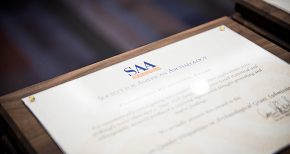Please be aware when registering, all times are in the Eastern Time Zone. Even for free events, you will need to click the "Proceed to Checkout" button and "Submit Order"
to complete your registration. If you do not receive an automated confirmation email, or if you have any questions about registration, please email
onlineseminars@saa.org.
Sampling Wet and Inundated Sediments and Soils in Archaeology [Foundational Skills]
When: September 10, 2025 3:00-4:00 PM ET
Duration: 1 hour
Certification: RPA-Certified
Pricing
Individual Registration: Free to SAA members; $69 for non-members
Group Registration: Free to SAA members; $89 for non-members
Dr. Ervan Garrison, PhD, RPA, University of Georgia
Dr. Garrison has recently retired from the University of Georgia where he taught geology and archaeology for 32 years. Archaeological sedimentology played a central role in his teaching and research, which encompassed the study of both terrestrial and lacustrine/marine sediments. From 1990 to 1992 he worked as a Marine Archaeologist at the National Oceanic & Atmospheric Administration (NOAA) and served as research faculty at Texas A&M University from 1979 to 1989. Dr. Garrison received his PhD. from the University of Missouri and both his B.S. and M.A. from the University of Arkansas.
Dr. Garrison has recently retired from the University of Georgia where he taught geology and archaeology for 32 years. Archaeological sedimentology played a central role in his teaching and research, which encompassed the study of both terrestrial and lacustrine/marine sediments. From 1990 to 1992 he worked as a Marine Archaeologist at the National Oceanic & Atmospheric Administration (NOAA) and served as research faculty at Texas A&M University from 1979 to 1989. Dr. Garrison received his PhD. from the University of Missouri and both his B.S. and M.A. from the University of Arkansas.
A significant portion of any archaeological site is often in the dirt aka “sediments.” Even until the mid-to-late 20th century, sediments were simply discarded and ignored at many excavations. Sediment analysis or sedimentology together with pedology is largely the province of geoarchaeology. The geoarchaeological study of inundated and submerged soils and sediments is a relevant sub-specialty since more and more academic and CRM studies focus on drowned landscapes. This seminar will focus exclusively on “drowned dirt” and how best to use it for archaeological ends. Color, texture, parent material, micro-and- macro inclusions, eDNA will be discussed as well as important laboratory and instrumental methods that assist in our understanding of wet sediments and soils.
1. Learn how to best sample wet sediments and how their study differs from that of subaerial soils and sediments.
2. Learn the basic steps in the collection and characterization of wet sediments.
3. Appreciate the importance of sedimentological/pedological study in archaeology.
2. Learn the basic steps in the collection and characterization of wet sediments.
3. Appreciate the importance of sedimentological/pedological study in archaeology.



![Sampling Wet and Inundated Sediments and Soils in Archaeology [Foundational Skills]](/images/default-source/default-library/untitled-design-(14).tmb-seminar.png?Culture=en&sfvrsn=9792d568_1)